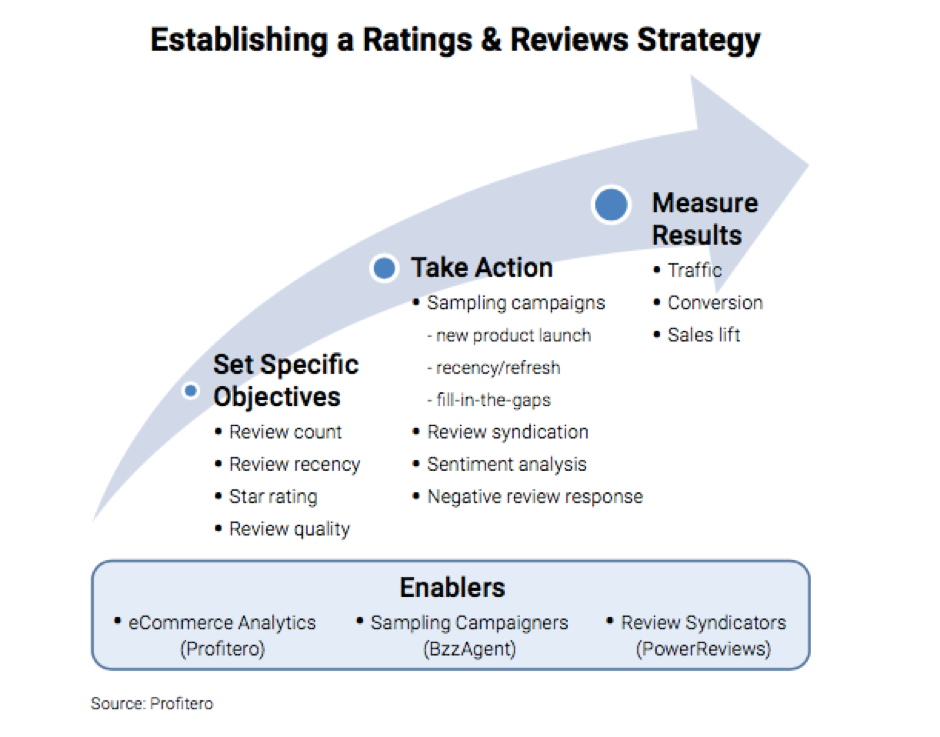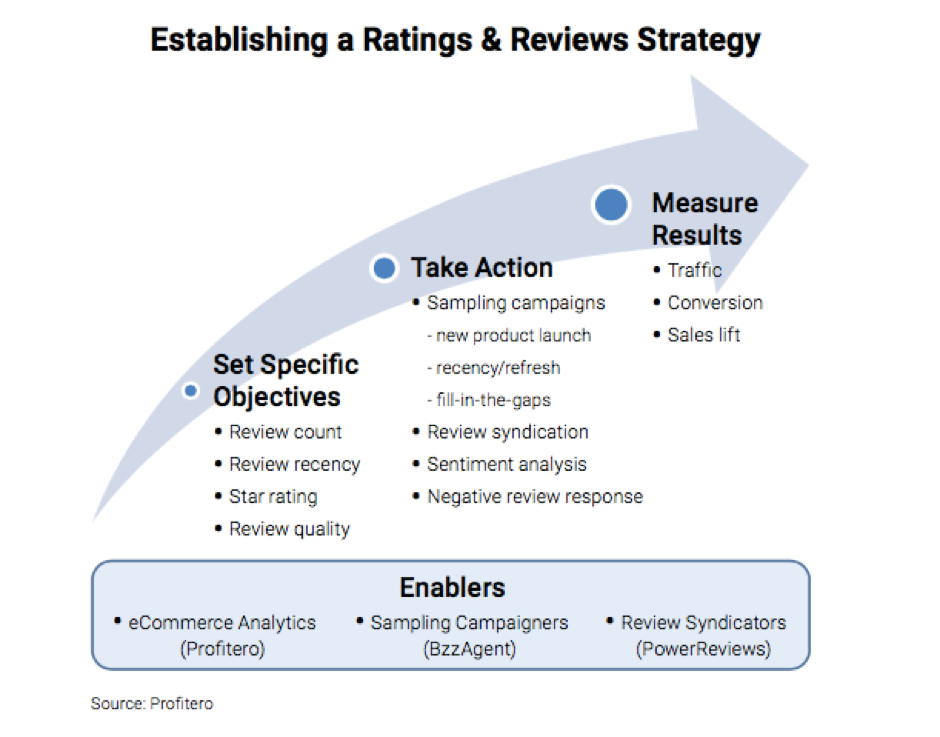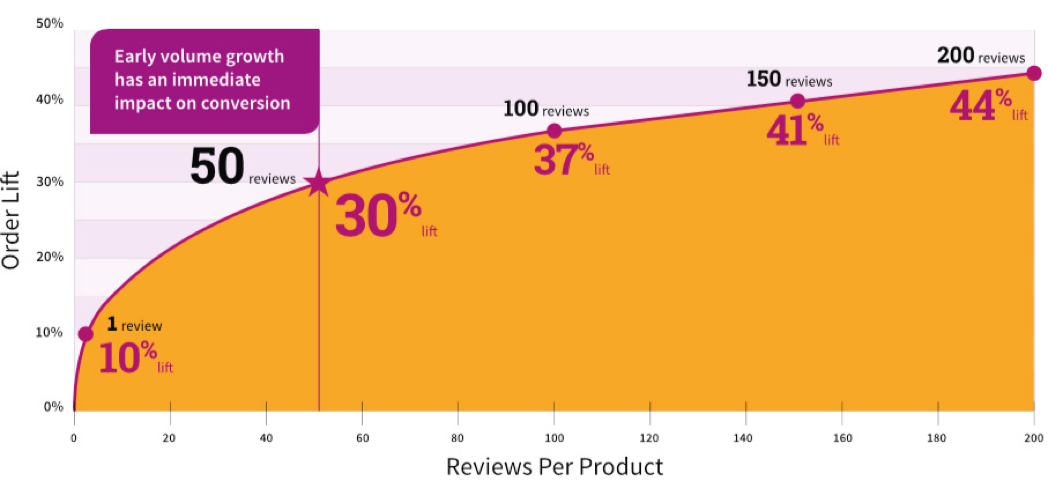

As we outlined in an earlier post, reviews matter. Having a sustained flow of high-quality, authentic reviews and systematically measuring their impact on traffic, conversion and sales, matters even more. Ratings and reviews can have a profound effect on online as well as offline performance.
Consequently, establishing a well-constructed ratings and reviews strategy could very well separate forerunners from also-rans.
Focus areas when setting up a ratings and reviews content plan should include:
- Setting specific goals and objectives, paying particular attention to metrics such as review counts, review ‘recency’, star rating and review quality.
- Taking action, which could take the form of sampling campaigns, review syndication, sentiment analysis and negative review identification and response.
- Measuring results, including increases in traffic and conversion, and ultimately sales lift.
- Teaming with enablers like eCommerce analytics firms, sampling campaigners and content syndicators to support brand and retailer strategies and help achieve set goals.

Benchmarking: The Role of KPIs, Metrics and Analytics
Leveraging consumer reviews to drive performance requires establishing a strategy, setting specific objectives and goals, taking action, and measuring results.
The most common and obvious KPIs are review count and star rating. Increasingly, brands also monitor and manage factors like review quality (e.g., length and context) as well as review “recency” or velocity (thinking about the “freshness” of reviews or if they have a steady stream of reviews coming in).
Review Count
Generally speaking, products with no reviews don’t tend to sell very well and aren’t typically trusted. To consumers, having no reviews creates the perception that they’re a guinea pig, i.e., the first to buy a product. So there’s a desire by brands to have greater than zero reviews.
The questions then become: How many reviews do I actually need? How many reviews is the right number?
BzzAgent’s Global Product Manager Darcy Reifenberger points to some industry research that addresses these kinds of issues. “Studies show that there is a change in sales conversion on an eCommerce site when a page goes from having zero reviews to some other number. After an initial burst of reviews, the sweet spot tends to hover around 35-50 reviews.
“Then it becomes a question of whether you really need any more than that? What the studies have shown is that there is a point of diminishing returns once you get much higher than 50. But where the value comes in is not necessarily building that volume all at once in one fell swoop. Instead, it’s best to make sure there’s a ‘recency’ or refresh plan built in with larger review volumes. This is where having a well-managed sampling campaign can help.”
More Reviews Mean More Orders

*Based on statistical modeling of transactional data from numerous product categories. Source: BzzAgent from dunnhumby, based on data from Bazaarvoice: Conversion Index Volume 8 Study – How Increasing Review Volume Drives Sales
Profitero’s analysis of the 100 Best Sellers on Amazon in the U.S. in March 2017 compared with a year ago reveals a near universal uptick in the average number of reviews across categories. A notable exception is Grocery & Gourmet Food, which is probably being dragged down by the large number of new product introductions annually, each of which may not yet have a sufficient number of reviews.
Also of note is that the Top 10 products in most categories, across both the U.S. and U.K., tend to have a larger number of reviews than the Top 100 category average, many of them with double or triple the average review count for the Top 100 Best Sellers. So clearly, review count matters.
Review “Recency”
Somewhat related to review count is a relatively recent development in Amazon’s algorithm that seems to factor in automation and personalization, what Profitero calls review “velocity” or “recency.” This has to do with not just the number of reviews, but the vintage of those reviews. For example, if a product has a lot of reviews, but they were all left during one concentrated Vine campaign and there hasn’t been any sustained or new organic reviews left in months, Amazon’s search algorithm now appears to penalize products with only “stale” reviews.
The old approach was to “get a lot of reviews close to launch, and we’ll be good.” The leading practice is transitioning from targeting an avalanche of reviews at a single point in time (e.g., new product launch, seasonal, etc.) to sustaining review generation during the lifetime of the product.
Star Rating
Star rating is important because if a product has enough reviews but doesn’t have a high enough rating, people still won’t buy it. Generally speaking, the floor to aim for is 4stars or better because research suggests conversion rates are much higher above 4 stars. This and the fact that most retailer sites have filters that actually let you filter and sort by star rating. Most consumers look for 4+ stars. Falling below 4 could eliminate a product from the consideration set.
Profitero’s research finds that the lowest average star rating of Amazon U.S. 100 Best-Selling products across categories is 4.2. The average star rating of the 100 Best Sellers fall within a 4.2 to 4.6 range. The range is 4.3 to 4.7 for Amazon U.K.
Quality
Review quality is difficult to quantitatively measure. BzzAgent’s Darcy Reifenberger notes, “Quality is not synonymous with sentiment. It doesn’t mean all reviews should be 5-star reviews. It means reviews should be authentic and well- formed; not just one-line phrases like: ‘It’s a great product!’ In order to influence purchase decision they should be informative. The challenge brands face is increasing the breadth and depth of quality review coverage across their entire product line on key destination sites.”
For further guidance on the importance of formulating a Ratings and Reviews strategy, download Profitero’s new white paper: Assessing the Impact of Ratings and Reviews on eCommerce Performance.


























